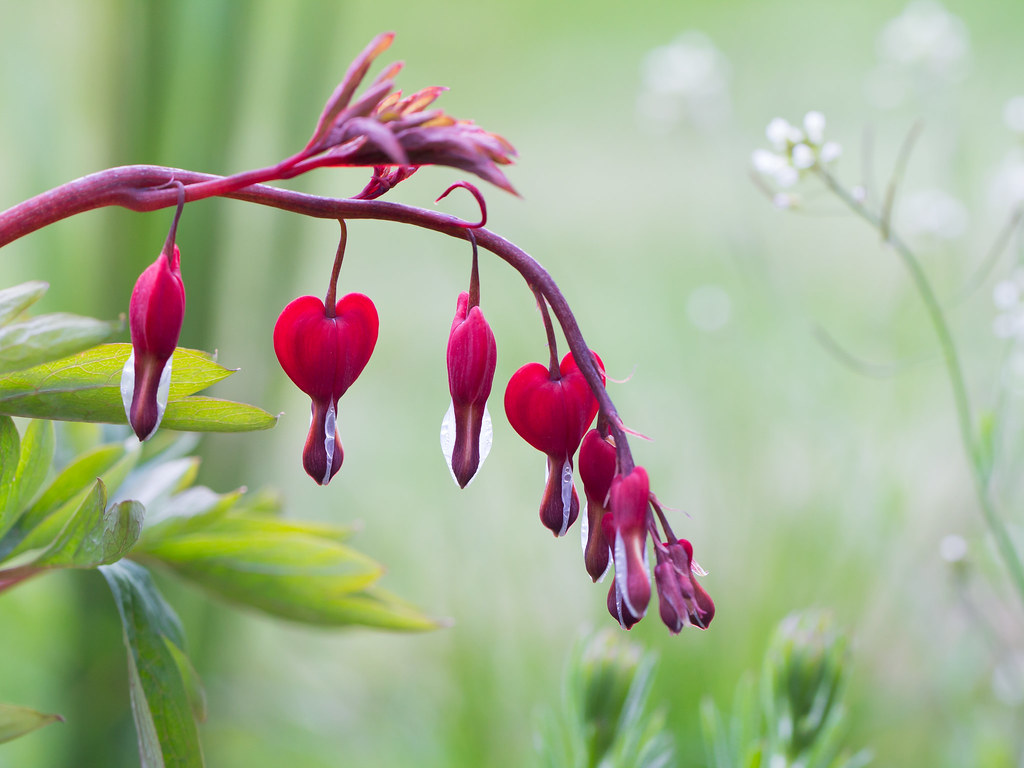Bleeding Heart Plant care: The Designer Beauty For Garden

Do you want to add some unique plants to your garden? Or do you want to have something which looks designer and vibrant? Well, we have the good news for you; both of these things can be done with the bleeding heart plant. What’s even amazing is that bleeding heart plant care is an easy thing, and all you need is to put in a little effort.
These little heart plants are one the most attractive varieties of flowering plants. The bleeding heart flower is in the shape of a heart and looks like heart-shaped pillows. The flowers got the name due to its heart-shaped flowers, which have a dangling pendulous which looks like a blood drop. These bleeding heart plants are a part of the Dicentra genus. There are also other plants in this genus.
In the article, we will tell you about the most popular variety of bleeding heart(L. Spectabalis) in the Dicentra genus. Other varieties of this genus are not cultivated and are mostly wildflowers. So, in the article below, we will explore bleeding heart plant care and aspects related to it.
Bleeding Heart Plant
The bleeding heart is a type of woodland plant which loves shades. They bloom in the cool season of the spring. Although these plants stay bloomed for many weeks, they can become ephemeral. This usually happens during the summers if you expose them to too much heat or sun.
However, the roots of these bleeding heart vine plants remain alive. This is why the plant grows back during the fall season or in the next spring season. The fringed leaf bleeding heart varieties repeat the bloom all through the summers.
You will need to cut the old ones and the best time to do it is during the early summers or springs. If you want to plant new ones, then you can go for bleeding-heart seeds. The best time to plant new ones using bleeding heart seeds is during the fall season.
What’s even amazing is that the bleeding heart grows on itself. This usually takes place from the seeds in the bleeding heart flower. But k ly if the flowers are bot deadheaded. These plants have a medium growth rate and reach the mature size in a period of 60
Bleeding Heart Plant Care
In a regular growing season, the bleeding heart plant generally produces around 20 flowers on each of the stems. This generally happens during the spring season. The foliage of the bleeding heart bush enters a dormancy state during the mid of the summers.
This sensitivity towards the heat makes the establishment of new bleeding heart bush in warm climates hard. In addition to this, the bleeding heart flower is delicate, and this needs protection against the strong winds. This is an important part of bleeding heart plant care, so remember to protect it.
The bleeding heart in general blooms at the same time like hellebores, Brunner, and pulmonaria. All of these plants contribute to the woodland cottage’s wonderful effect. The plant stays in bloom for several weeks; however, the bleeding heart bush foliage goes down once it’s done flowering. The good thing is that you can plant some late-growing plants in nearby areas. This will help you in keeping the bloom when the bleeding heart plant goes dormant or disappear.
Some of the best options include hosta, ferns, monkshood, foam flower, and coral bells.
The good thing is that these plants are trouble-free, and thus, bleeding heart plant care is easy. However, they can suffer from Some general problems like powdery mildew and aphids occasionally.
Light For Bleeding Heart Plant Care
The bleeding heart does great in the shady spots, and this is why planting it in areas where it can get protection from the sun is essential.
The best spot which you can choose for planting it is near a deciduous tree. This is because the deciduous tree will provide it protection from the heat of the sun. Since the bleeding heart is an early bloomer, the tree will protect it. The plant will be growing and well up before the tree goes out.
Soil
The bleeding heart plant loves the most soil, which is rich in humus and organic matter. However, this plant is not too much particular about the pH levels of the soil.
The plant prefers the soil, which is slightly acidic in nature, but it also does great in neutral soil types. For the best results, spread a layer of organic matter which is at least 2 inches to 3 inches in size. You can use the well-rotted types of manure or compost in the form of organic matter. Make this layer of organic matter over the already existing soil.
One thing to know is that work the layer will help in improving the airflow. It will also help in creating loose soil, which will allow the roots to grow easily.
Water
Watering plays an important role in bleeding heart plant care. You will need to keep these plants well-watered throughout the summers, especially if you live in warm climatic regions.
However, even after the regular watering, the bleeding heart vine may disappear during the summers until the arrival of fall or the next spring. In case you have planted the bleeding heart vine recently, then mark the area. This will help in avoiding accidental digging up of the spot while the plants are in a dormant state.
The western variety of the bleeding heart is comparatively more drought-tolerant than other species of this plant. However, it is still the best thing to treat all varieties like the woodland plants. So, provide them with moisture regularly, but it doesn’t mean a wet environment – don’t overwater them.
Humidity And Temperature
Temperature and humidity play a vital role in bleeding heart plant care. These plants will start to turn yellowish when the summer heat starts to ramp up.
However, you don’t need to worry, as this is a sign that the plant has begun to store the energy for the winter season. The ideal temperature for the bleeding heart plant is between 55 degrees to 75 degrees Fahrenheit. This plant also has good tolerance towards humidity.
Fertilizer
The bleeding heart plant is not a type of heavy feeder, and this is why the fertilizing depends on the soil quality of your region.
In case the soil in your region is rich in organic content and is amended on a yearly basis, then you don’t need to feed these plants at all. The bleeding heart is a type of woodland plant, and this is why they especially do great if you provide them with a leaf mold dressing on top.
Is The Bleeding Heart Plant Toxic?
The bleeding heart plants contain isoquinoline alkaloids. This chemical is toxic to both animals and humans, and so you should be careful in the bleeding heart plant care.
The serious cases of poisoning in animals like horses and dogs are very common. However, poisoning from these plants in humans is not that common.
What Are The Symptoms Of Poisoning From Bleeding Heart?
If humans ingest large quantities of the bleeding heart, then it can lead to liver damage along with seizures in humans.
The small-sized dogs are especially at the risk of poisoning from these plants as they can be affected even with limited exposure. Other than the dogs, the horses which graze on the bleeding heart plant are also prone to poisoning. Humans should also avoid eating any of the parts of this plant. If they do so, they can experience skin irritation or rashes on mild levels.
You should also be especially careful when going for bleeding heart plant care to avoid any poisoning.
Bleeding Heart Plant Varieties
The Lamprocapnos Spectabilis genus of plant has numerous varieties and cultivars. Other than this, there are also some other popular species with similar characteristics in growing.
Some of the popular varieties are:
- Lamprocapnos Spectabilis or ‘Alba’: This variety is one of the favorite ones among the gardeners. It has attractive heart-shaped flowers in white color.
- ‘Gold Heart’: The gold heart variety of this plant has golden-yellow foliage along with pink flowers.
- ‘Valentine’: This variety has cherry-red color blooms in bright colors. The blooms have white tips. Its stems are of burgundy color.
- ‘Fringed-Leaf’: This variety of the bleeding heart is native to America and has ferny delicate foliage. Its foliage blooms on repeat throughout the summer season. It is a very popular variety of this plant which has attractive pink flowers.
- ‘Dutchman’s Breeches’: This is a species of the plant which is very similar to the bleeding heart plant. It has white pantaloons which look like hearts.
These are some of the cultivars and varieties which you can grow in your garden for an attractive and interesting outlook.
Bleeding Heart Pruning
No deadheading or pruning is required in the bleeding heart plant care as it will bloom once again in the season. If you want the bleeding heart seeds, then you can leave the flowers as they are.
However, you can trim the foliage back when it begins to tuner ugly in looks. The fringed leaves variety if this plant will get a little ragged eventually in their looks. This is why you can shear back them to their basal levels of growth. Later these plants will rebloom and re-leaf again in the season.
How To Propagate The Bleeding Heart?
The bleeding heart plant is normally planted from the seedlings of a nursery. However, you can also propagate them using the bleeding heart seeds, divisions of clumps, or by using cuttings from stems.
Propagating By Using Seeds
Follow these steps for propagating by using the seeds:
- For propagating these plants with the use of seeds, you will need to place the seeds inside a pot of the soil.
- Not put the pot inside a plastic bag and then place it inside a freezer for a period of at least six to eight weeks.
- Now remove after the passing of six to eight weeks remove the pots from the freezers. Now simply allow the seeds to germinate on their own and let them grow into the regular type of seedlings conditions.
- The seeds of the bleeding heart plant can also germinate on their own in the garden. However, they don’t germinate to the level that they become a nuisance.
- After the seedlings develop from the plants, you can carefully dug up some holes and then transplanted them carefully.
These are some of the steps which you need to follow for propagating these plants from the seeds.
Propagating By Using Division
Follow these steps for propagating through the division method:
- Diving the root clumps off the bleeding heart plant is very easy.
- You can do this after the bleeding heart flower season is complete.
- This is because it will help you in avoiding the sacrifice of the bloom.
- The fringed leaf cultivars of this plant divide nicely during the early spring season. They will do so as they are only emerging.
These are some of the steps which you need to follow for propagating by the process of division.
Propagating By Using The Cutting
Follow these steps for propagating through the method of cuttings:
- Cut a part of the stem carefully.
- The part which you cut should have some leaves on it.
- Now remove the leaves except those on the topmost corner of the stem.
- Now using a growing medium, plant the cuttings.
- Wait for 3 to 4 weeks, and you will see the growth of new leaves on the stem cuttings.
These are some of the steps which you need to follow for the propagation of the bleeding heart plant using cuttings.
Pest And Disease
The bleeding heart plant care is easy as it is fairly free of any troubles. However, it can still face some of the problems like:
- Powdery mildew or aphids might attack it occasionally.
- The leaves of this plant are also susceptible to damage like leaf spots. The easiest solution for this problem is to shear back the foliage affected.
- In the case of the other pest, you can use the simple solution of soap and water for removal.
These are some of the bleeding heart plant care tips which you should know. The good thing about this plant is that it is easy to care for and grow. Other than this, there are numerous cultivars out of which you can choose the best for your home. In addition to this, there are bleeding heart bush and bleeding heart vine and plant. So you get to choose which is best for you.
Final Words
Do you want to add something romantic to your garden? Or do you want to add a unique plant to your garden? Well, then the bleeding heart plant can help. The good thing is that bleeding heart plant care is also easy.
This plant doesn’t require much care and all you need to do is water it during the spring season. Other than this, it doesn’t require any kind of pruning or fertilizers, and it is also one of the best options when you want shade plants.






